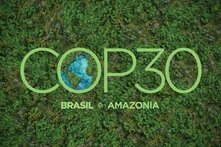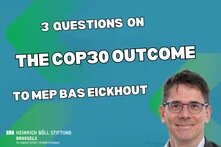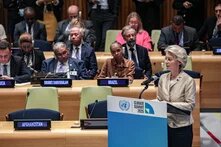COP26 was supposed to be the “most inclusive COP ever”. Lisa Tostado reports on why the promised cannot be considered fulfilled and where inclusion and representation remain an issue to be addressed urgently.

Read our web dossier on the COP26.
At the beginning of COP26, the UK Presidency received the ironic “Fossil of the Day” award. The initiative by the Climate Actin Network rewards countries who are “doing the most to achieve the least” in terms of the progress in the climate negotiations and climate action. The UK received it for failing to make the COP the promised most accessible climate summit “ever” and hindering civil society’s access to negotiations. Back in September 2020, a global coalition of more than 1500 green groups on Tuesday called for the COP26 to be postponed due to fears that delegates from the world’s most vulnerable countries face exclusion. As a response, the U.K. government committed to funding quarantine stays for delegates from red list countries and to ramping up vaccinations.
Problems, though, remained. COP26 attendees faced major difficulties, both in preparation of the trip to Glasgow (changing travel rules, testing, vaccines, visas, very pricy accommodation), once on site (long lines, restricted access to the venue and negotiations, lack of accessibility for people with disabilities) and even virtually (unexpected barriers to observers wishing to use the virtual platform). One consequence is a low representation of people and groups with fewer financial means and a lower organizational capacity, especially from the Global South. This is a structural problem with COPs and the Covid-19 pandemic made matters worse, but it is fair to say that the UK Presidency could have done a better job.
I have personally experienced several moments during which social distancing between people from all over the world was not possible. People with poor health or with vulnerable friends or family members cannot feel comfortable.
To understand the importance of having voices from across the board included, let’s take a look at a central theme of COP26: net-zero emission objectives. They often include mass reforestation, biomass, offsetting and geo-engineering technologies. Many indigenous peoples are weary of such net zero pledges as they are worried that they will lead to further land grabs and environmental and cultural destruction, instead of focusing on keeping fossil fuels and minerals in the ground. The Paris Agreement legally recognizes the crucial role of traditional knowledge and innovations by local communities and indigenous peoples in understanding and mitigating the climate crisis. Yet, although research shows the climate, biodiversity, and sustainable development benefits of their forest management are massive and extremely cost-efficient, such communities only receive an equivalent to less than one percent of Official Development Assistance (ODA) for climate change mitigation and adaptation. This lack of finance is also a result of the exclusion of voices from the impacted areas excluded from climate negotiations.
For human and environmental rights defenders from indigenous communities, participating in the COP process has never been easy because of the hard-to-navigate bureaucracy and organizational and financial constraints. This time around, lack of access to Covid-19 vaccines, complicated travel rules and the high accommodation costs in Glasgow added onto these structural barriers. Still, some did make it and are visible to COP attendees, both in the official blue zone and the mass demonstrations that took place on Friday and Saturday. Physical presence alone is, however, only a necessary condition for a better chance to get their voices heard. It is not sufficient. Eriel Deranger, executive director of Indigenous Climate Action, told the Guardian: “Indigenous people are more visible but we’re not taken any more seriously; we’re romanticized and tokenized. People like me still tend to be left out of the actual decision-making and positions of power.” On a similar token, I am not aware of any significant media coverage of a public intervention by a group of indigenous peoples on Friday’s March in Glasgow. Yet, they took the stage for 30 minutes, longer than any other speaker and were at the frontline of the demonstration. Most media outlets focused on Greta Thunberg for their reports on the strike on Friday. She had been expected to address the crowds again on Saturday, but cancelled her speech to allow for more space for people from marginalized backgrounds to be heard.
While the Swedish teen is an earnest, admirable and important figure, the focus on her is a problem. At least in the past, the media in Europe have often referred to global climate activists as the “Greta Thunberg” of their country, following in her footsteps, even in cases where they started their actions before she started hers. The most recent headlines often read “Greta Thunberg “led” protest in Glasgow. It would be more accurate to say that she, but also many passionate volunteers from around the world organized the marches, some of them from Fridays for Future, the movement inspired by her climate strike. There has been some progress on covering speeches and activities by other young leaders, for example with activist Vanessa Nakate from Uganda being on the cover for TIME Magazine’s October 2021 Issue. Yet, a photo from this year’s COP shows Scotland’s First Minister Nicola Sturgeon in a seemingly one-to-one meeting with Greta Thunberg, even though Vanessa Nakate was right there with them (by the way, the COP26 Presidency has invited to speak during the open ceremony or the main platform). The same thing happened back in 2020 when several articles used a cropped photo of climate activists, excluding Vanessa Nakate who then said, “You didn’t just erase a photo. You erased a continent.”
Looking at the faces of the young climate movement, one may think that at least the assessment of gender equality of UN climate negotiations will be favorable. Mostly due to structural inequalities – i.e. underrepresentation of women in political positions in almost every country on earth — this is unfortunately not the case. A 2020 report by the UNFCC on the matter even shows some backlash on gender parity: The trend towards more gender-balanced bodies that was reported in 2018 has reversed in 2019 and 2020. In 2020, only two constituted bodies out of seventeen reported having close to a balance in gender. SHE Changes Climate, a campaign founded last year to call for equal gender representation in climate negotiations, complained that men take up 10 of the 12 UK leadership team positions. In a letter, supported by over 450 male and female environmental leaders, they demanded more transparency and accountably on gender parity.
Examining the wider composition of the U.K. COP26 team, the female ratio is higher (45 percent), but their roles tend to relate to event organizing or other activities rather than the core team members. This gendered division of labor is characteristic of the system of UNFCCC climate negotiations. On average, female members of constituted bodies occupy 33 percent of all the positions in a body in 2020. The ratio for parties’ delegations is better, 40 percent, however only 27 percent of heads and deputy heads of delegations are female.
Without a better inclusion and representation, outcomes cannot be adequate. Actions to achieve that include immediate measures, still possible for this year’s COP. The Special Rapporteur on Human Rights and the Environment and the Special Rapporteur on Hazardous Substances and Human Rights outlined some of them in a joint letter to COP26 President Alok Sharma on November 4. Many issues are structural, such a lack of women in political decision making, a lack of inclusion of civil society voices in climate finance or biased media coverage. Different actors need to work together to make sure that future climate negotiations do give reasons anymore to be awarded the “Fossil of the Day”.


